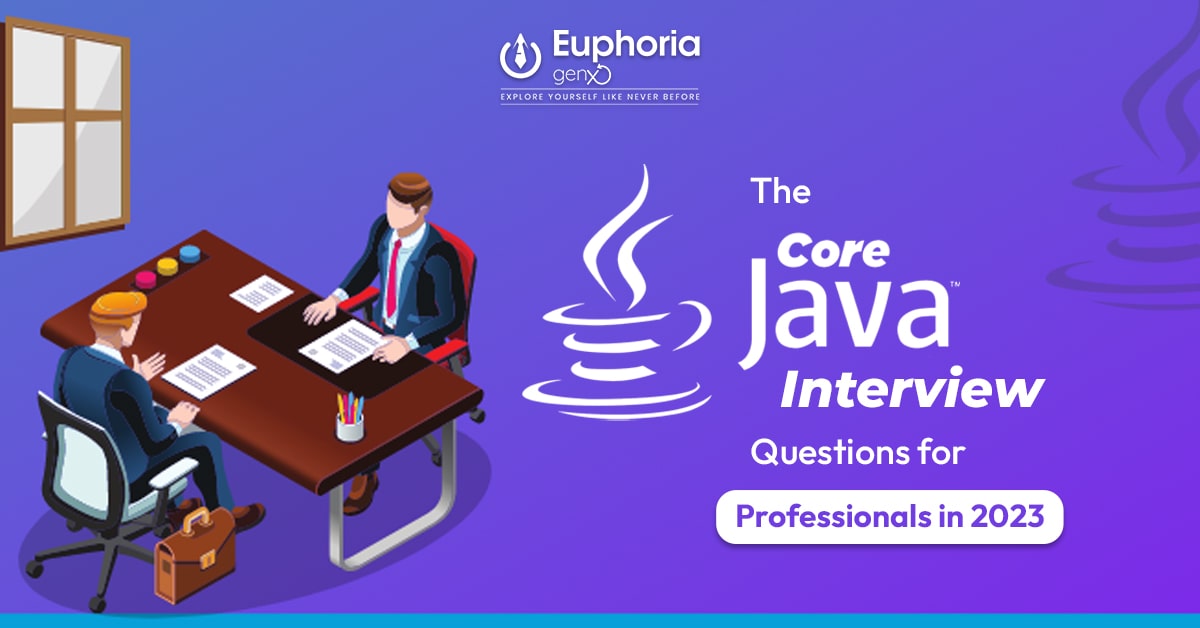

Programming languages such as Java are widely used in the IT industry today. One of the main reasons why Winter Training in Kolkata is so popular for beginners and professionals is its career potential. We’ve compiled a comprehensive guide on how to answer the most frequently asked Java interview questions.
Now, let’s check out the 34 most significant FAQs on Java below-
The significant features of Java are-
Easy: Java is considered an easy language to learn.
Secured Feature: Java has a security feature that keeps the user’s system safe from viruses and tampering.
OOP: An object-oriented programming language is called an OOP language. As a result of OOP, everything in Java is regarded as an object.
Independent Platform: Rather than compiling into a platform-specific machine, Java creates platform-independent bytecode. Platforms run on these Virtual Machines that interpret this code.
A method called Equals () is defined in Java’s Object class and it is used for checking the equality of two objects created by business logic. Objects and primitives are compared using the “==” operator, a binary operator in the Java programming language. The Object class provides the method public Boolean equals (Object o). Two objects are compared using the == operator by default. It is possible to override methods like String class, for example. When two objects are compared, the equals () method is used.
Java is run on computers using Java Virtual Machines. Java Virtual Machine (JVM) runs Java code by calling the main method. Computer systems must implement the JVM specification. However, the code is compiled by JVM to become Bytecode which is machine independent.
The class loader is a subsystem of Java Virtual Machine, that loads class files. It is possible to load classes in Java using three different class loaders.
Bootstrap Class Loader is the first-class loader. All the Java Standard Edition classes are loaded by rt.jar, which contains the java. Lang, java.net, java. util, java.io, java.sql and java. Interface package classes.
In this class loader, Bootstrap is a child and System is the parent. In this case, it loads the jar files contained in the $JAVA_HOME/jre/lib/ext directory.
Among the Extension class loaders, this is its child class loader. Using the classpath, it loads the class files. The current directory is set as the classpath by default. You can change the classpath using the “-cp” or “-classpath” switch. It is also known as an application class loader.
Constructor in Java refers to terminology that is used to create an instance of a class object. It must have the same name as that of the class. Mainly there are two types of constructors-
An object-oriented programming paradigm consists of objects with data and methods defined in the class to which they belong. Reusability and modularity are key features of the object-oriented paradigm. Applications and programs are designed using objects, which are instances of classes. A paradigm based on object-oriented thinking has the following characteristics.
It enables Java bytecode to be executed on a computer through a virtual machine.
Java source files are compiled into bytecode files, which are executed by Java Virtual Machines. Programmers no longer have to rewrite or recompile applications for each different platform since Java was designed to run on any platform. A virtual Java machine makes it possible as it is aware of some specific particularities and lengths of the underlying hardware platforms.
It is common to perform similar functions in C++ and Java, but there are a few subtle differences that influence the way they are used. First, define the two concepts to demonstrate their differences. Additionally, you can discuss the appropriate situations in which both languages should be used and your experiences with them.
Applicants for software developer positions should be knowledgeable about Java’s core functionality, such as memory. To demonstrate your knowledge of these two memory types, you can provide an answer. In your interview, explain how each type of memory can help you make a good impression.
In Java programming, it is important to distinguish between variables that developers exchange.
Instance Variable: An instance variable is declared within a class but is not used inside any method, constructor, or block.
Local Variable: A variable within a method without any default value.
There are slight differences between C++ and Java, but they perform similar functions. You can also talk about your experience using both languages and the appropriate situations for their use. The differences are-
| C- Language | Java |
| Dennis M. Ritchie in the year 1972 developed the C language. | James Gosling in the year 1995 developed JAVA. |
| C is a Procedural-Oriented language | Java is an Object-Oriented language |
| Here, functions play a major role. | Here. objects play a major role. |
| Middle-level language. | High-level language. |
| OPS Concepts does not support O | OOPS, concepts support here., in which Inheritance is the main property used for code reusability. |
| Here, memory is allocated using Malloc | Here, memory is allocated using a new keyword. |
| Here, the threading concept is not supported. | Here, Java supports threading |
| Portable | Portable |
| Default members are public | Default members are private |
| Storage classes are supported. | Storage classes are not supported. |
JVM
A Java Virtual Machine (JVM) is an abstract machine that executes Java bytecode by providing the runtime environment for it. Java Virtual Machine specifications describe how the machine works. Several companies have implemented it, including Oracle. JRE is its implementation.
Many software and hardware platforms support Java Virtual Machines (JVMs). Java classes are runtime instances that are created when they are executed. The JVM is divided into three parts: specifications, implementations, and instances.
JRE
Java Runtime Environment is also known as JRE. It is the implementation of JVM. JRE is a set of software instruments used to develop Java applications. It provides the runtime environment by implementing JVM. It contains a set of libraries with other files that JVM uses at run time.
JDX
JDX is an acronym for developing a Java kit. A software development environment which is used to develop applets and Java applications. It contains JRE development tools. It is an implementation of the enterprise edition Java platform, standard edition Java platform mummy and micro edition Java platform.
There are basic differences between object-based language and object-oriented language.
An object-oriented language follows the concept of OOPs and an object-based language does not follow the concept of OOPS like polymorphism and inheritance.
Object-based language has inbuilt objects, for example, JavaScript has window objects whereas Object-oriented languages do not have inbuilt objects.
Examples of object-oriented programming are small talk, Java, and C#
A program is a non-active entity that includes the collection of codes necessary to carry out a specific operation. When a program is run, an active instance of the program called a process is launched.
Java is one of the most widely used programming languages that is independent of the platform. Java never demands that the complete program should be retained for every possible platform. Any JVM operating system can easily run on this platform with neutral byte code. The application is run after JVM translates the byte code into the machine code. As Java programs can operate on different systems without individually rewriting for each platform.
A program being a non-active entity includes a collection of quotes which is necessary for carrying out a specific operation. An active instance of the programme process is launched whenever a program is run. A process is begun by a program once it has been run properly.
Java does not allow you to do what you want. Each Java application will use a different JVM, separated into its own ‘black box’. There are two options, however:
Channels (or sockets) can be used. A listening socket is opened by one application and a signal is waited for by the other application. When another application has completed something, it will send a signal there. The method used in 99.9% of applications is this one.
Java supports calling winapi.
A feature called eager loading involves fetching all collections when a parent class is retrieved. The execution of a query associated with an entity includes queries related to similar entities as well.
With the include() method, you can achieve eager loading.
Technical interviews frequently ask this advanced Java interview question. Encapsulation is one of the core Java OOPS features which binds together objects and data. It is possible to achieve encapsulation in a program by making the Data members of a Class private.
Java interview questions about advanced concepts are a common part of technical interviews. A Garbage Collector runs a thread that monitors no longer-needed or unreferenced objects, releasing memory for new objects to be created.
As a result, the system is overloaded and execution is delayed. Implementing Mark and Sweep becomes difficult when garbage collectors are used.
The scope of a Web application object indicates its lifetime and availability. Web applications have several different scopes. Each is briefly described below.
Page:
Servlet service methods are initiated when a request enters them and end when a request leaves them.
Request:
An object’s scope is started when it enters a Web Component’s scope and ends when it leaves it.
Session:
Clients enter the session when they make a request, and the session ends when they leave.
Context(or)application:
It commences and ends with the start of a Web application.
Web.xml contains the init-param> tag, which will initialize ServletConfig parameters
Web.xml contains the <context-param> tag part to initialize the parameters in the ServletContext object.
A garbage collector is a component of a Java Virtual Machine which reclaims memory from dead objects. It is a key component that allows the developer to focus on application development rather than working on memory management.
What do you mean by a heap dump?
Many tools help to analyze heat dumps in Java. Like you can use the chat tool which comes with JDK. You can also use an eclipse memory analyzer to analyze the keep dump in finding a memory lake in Java.
As the name suggests it is a pool of database connections. While creating a new database connection in real-time is an expensive process and also it slows down the responsive time. However, when a request comes in, it retrieves the connection from the pool and gets the data from the database. Hence, in this way, the response time is improved in Java web applications.
Java supports and provides the creation of both interface and abstract classes. Both share common characteristics but they differ slightly-
A race condition in Java is a condition where two threads raise a request for a similar resource. Rest conditions occur while running two programs parallelly whenever multiple threats simultaneously request resource allocation.
The mean disadvantage of using garbage collectors in Java is an increase in load on the system. As garbage collectors continuously monitor the objects that are not referenced or are no longer needed so they run their thread to free up the memory. This increases the pressure on the system and hence delays the execution.
A code object-oriented feature in java is polymorphism. With the help of this feature, a task can be performed in different ways. Polymorphism occurs when multiple classes are related to each other. Runtime polymorphism and compile time polymorphism are two ways by which the data of polymorphism is exhibited in Java.
A lazy loading feature in java is a process of an object which is delayed until A thread is ready to use it. By using this feature a java object is initialized only when it is time for it to use the program.
The Java virtual machine throws an OutOfMemoryError when there is insufficient RAM to run the application. For example, the Java virtual machine does not have enough memory to create new objects. When there isn’t enough memory to create a new object, java. lang.OutOfMemoryError: Java heap space occurs.
The JDBC stands for Java Database Connectivity and provides APIs and guidelines for connecting to a database from Java, whereas JNDI stands for Java Naming and Directory Interface and provides a logical structure for retrieving resources such as databases, messaging queues, enterprise Java beans, without knowing the physical locations of them like the host and port.
JNDI enables you to register resources so that others in your application can access them using their JNDI names. Most web servers like Tomcat or WebLogic access the database connection pool via JNDI.
In Java, the access modifiers are a type of special keywords used to restrict the access of a constructor, class, data member and method in another class. Java supports mainly four types of access modifiers:
Default
Private
Protected
Public
Break
Continue
It is a java term that refers to the combination of two processes. There are two braces used in which the first breast creates an anonymous inner glass. However, the second breast is an initialization block. This is known as double brace initialization when these are used together. The inner class has a reference to the enclosing outer class which is generally used in “this” pointer. Generally, it is used to neutralize the collections and reduce the code to make it more readable.
It is immutable in nature because once the string object is created it cannot be modified further. However, when you try to update the value of the object instead of updating the value of a particular object, Java creates a new string object. The objects of Java are immutable as string objects are cached in the string pool. As string literals are shared between multiple clients so one client might affect the rest. However, it enhances the catching synchronization security and performance of the application.
It is recommended that if you take Winter Training in Advance Java then you must go through this list of Java interview questions. JEE, and J2EE support engineers. At least the first few rounds of your Java interview can be aced by preparing these Java interview questions, regardless of your experience level. I would appreciate it if you could let me know if you come across any other interesting questions that are not on this list by commenting on this post.


© 2026 Euphoria GenX. All Rights Reserved